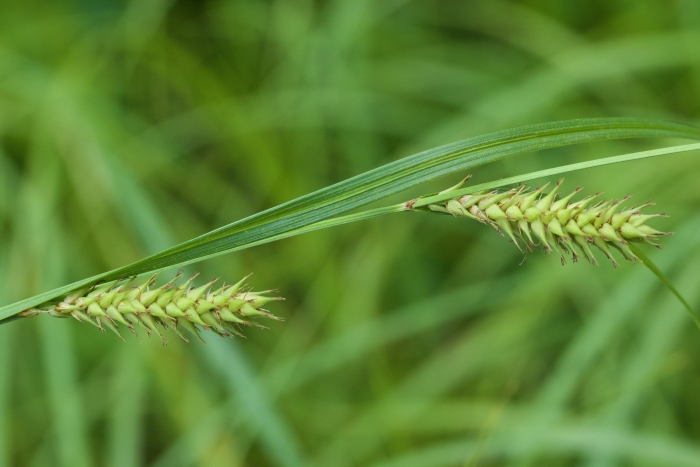Hairy-Fruited Sedge
(Carex trichocarpa)
Hairy-Fruited Sedge (Carex trichocarpa)
/
/

Owen Strickland
CC BY 4.0
Image By:
Owen Strickland
Recorded By:
Copyright:
CC BY 4.0
Copyright Notice:
Photo by: Owen Strickland | License Type: CC BY 4.0 | License URL: http://creativecommons.org/licenses/by/4.0/ | Rights Holder: Owen Strickland | Publisher: iNaturalist | Date Created: 2021-06-19T14:00:50-07:00 |

























Estimated Native Range
Summary
Carex trichocarpa, commonly known as hairy-fruited sedge, is a perennial sedge native to wet meadows, marshes, and the edges of ponds and streams in North America, particularly in the Great Lakes region and the Northeastern United States. It typically grows to a height of 20-100 cm (8-39 inches), with a clumping habit that forms dense tussocks. The plant features narrow, grass-like leaves and produces brown, hairy fruits (perigynia) that give it its common name. The flowering period extends from late spring to early summer, and while the flowers are not particularly showy, they are ecologically significant.
Hairy-fruited sedge is valued for its role in wetland restoration and erosion control due to its dense root system. It is also used in rain gardens and as a naturalizing element in moist garden areas. In cultivation, it requires consistently moist to wet soils and can tolerate a range of light conditions from full sun to partial shade. While generally low-maintenance, it may require division every few years to maintain vigor. This sedge is also noteworthy for its association with the two-spotted skipper, Euphyes bimacula, whose larvae depend on it for food, highlighting its importance in supporting local biodiversity.CC BY-SA 4.0
Hairy-fruited sedge is valued for its role in wetland restoration and erosion control due to its dense root system. It is also used in rain gardens and as a naturalizing element in moist garden areas. In cultivation, it requires consistently moist to wet soils and can tolerate a range of light conditions from full sun to partial shade. While generally low-maintenance, it may require division every few years to maintain vigor. This sedge is also noteworthy for its association with the two-spotted skipper, Euphyes bimacula, whose larvae depend on it for food, highlighting its importance in supporting local biodiversity.CC BY-SA 4.0
Plant Description
- Plant Type: Grass
- Height: 2-4 feet
- Width: 1-2 feet
- Growth Rate: Rapid
- Flower Color: N/A
- Flowering Season: Spring, Summer
- Leaf Retention: Deciduous, Semi-deciduous
Growth Requirements
- Sun: Full Sun, Part Shade
- Water: High
- Drainage: Medium, Slow
Common Uses
Bird Garden, Erosion Control, Low Maintenance, Water Garden
Natural Habitat
Wet meadows, marshes, and the edges of ponds and streams in North America
Other Names
Common Names: Woollyfruit Sedge, Bristly Cattail Sedge, Hairy-Fruited Lake Sedge
Scientific Names: , Carex trichocarpa, Carex aristata subsp. trichocarpa, Carex trichocarpa,
GBIF Accepted Name: